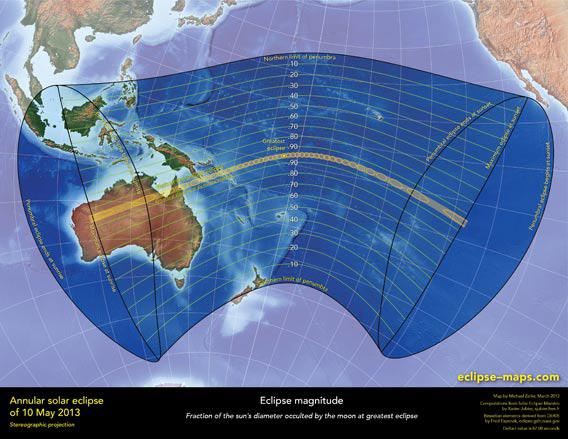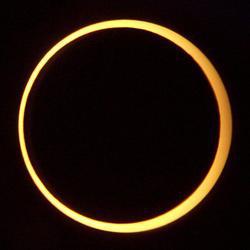On May 9/10, the Moon will pass directly in front of the Sun for people living in Australia and southeastern Papua New Guinea. This event is called a solar eclipse, but this one’s special: the Moon is nearing apogee, its farthest distance from the Earth in its orbit, so it appears slightly smaller than the Sun. That means it cannot block the Sun completely, leaving a ring or annulus of Sun around the edge. That’s why this is called an annular eclipse; at most about 95 percent of the Sun is covered by the Moon.
That means even if you’re directly in the path of the maximum eclipse, you won’t see the sky go dark, and you won’t see the corona, the Sun’s ethereal outer atmosphere. But an annular or partial eclipse is still pretty nifty, and worth taking a look.
First, let me clear up the timing. The eclipse starts when the edge of the Moon just nicks the edge of the Sun. That happens today, on May 9, around 21:25 UTC (depending on your exact location; see below). But Australia is way ahead of UTC (Greenwich time); for example, Sydney is 10 hours ahead. So for them, the eclipse would start around 07:25 a.m. on May 10. For me, in Boulder Colorado (UTC - 6) it starts at 15:25 (3:25 p.m.) local time on May 9—but I won’t see it from here at all, because the geometry is wrong. It’s only visible in the southern hemisphere (see the map below).
Wikipedia has some good info on the eclipse (including maps), as does, of course, NASA. The NASA site has a cool interactive Google Earth map with timings listed that appear to account not only for time zone difference but for geometry as well: Even in the same time zone, the eclipse will start at different times for different locations due to the viewing angle to the Moon (like two side-by-side observers seeing a nearby car pass a distant tree at two slightly different times). So if you want to catch the exact moment the eclipse starts, check there! My pal and astronomer Astropixie has some links, too.

Illustration by Michael Zeilik
If you do live in the right area, I suggest checking out astronomer Michael Zeilik’s eclipse-maps.com, which has fantastic and beautiful maps of the eclipse path. He has even more links there for info. I also have a page with lots of links on how to safely observe an eclipse. Seriously, don’t observe it without taking adequate precautions first!
However, if you don’t live Down Under, the eclipse will be live streamed by several places. One of them is the Coca Cola Space Science Center in Georgia (a great hands-on museum; I spoke there once); they have an expedition they’ve sent to Australia equipped with a telescope, and they’ll have it all live online. A web search will turn up other live webcasts, too.
I saw an annular eclipse a great many years ago, and it was pretty cool. I’ve still never seen an actual 100 percent total solar eclipse. It’s one of the very few astronomical events left on my bucket list to see (another being a full-blown aurora). Someday…but for now, I’ll watch this one online.
